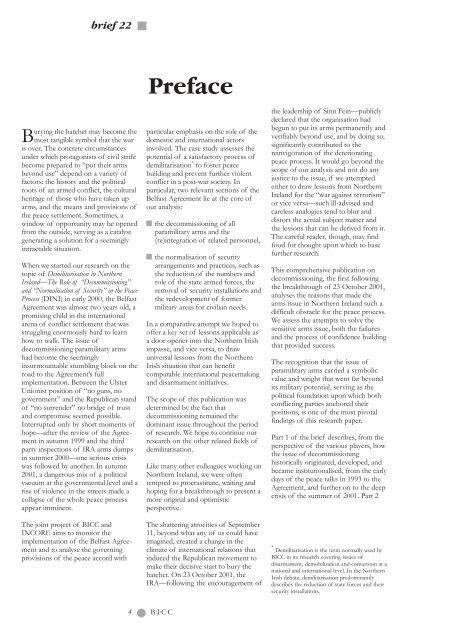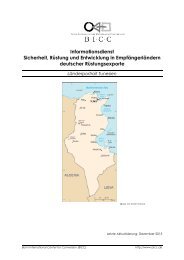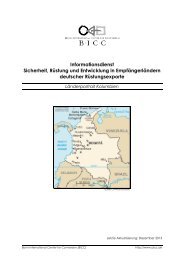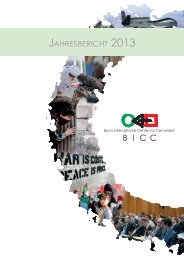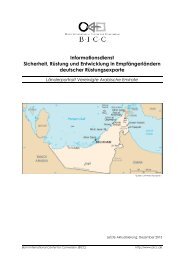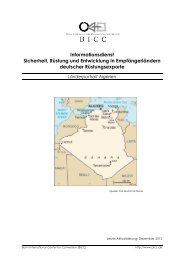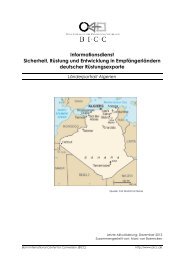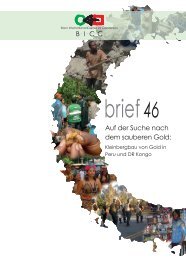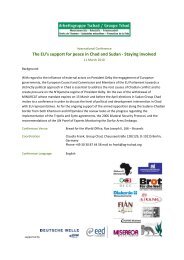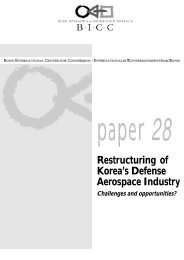English - BICC
English - BICC
English - BICC
Create successful ePaper yourself
Turn your PDF publications into a flip-book with our unique Google optimized e-Paper software.
ief 22<br />
Burying the hatchet may become the<br />
most tangible symbol that the war<br />
is over. The concrete circumstances<br />
under which protagonists of civil strife<br />
become prepared to “put their arms<br />
beyond use” depend on a variety of<br />
factors: the history and the political<br />
roots of an armed conflict, the cultural<br />
heritage of those who have taken up<br />
arms, and the means and provisions of<br />
the peace settlement. Sometimes, a<br />
window of opportunity may be opened<br />
from the outside, serving as a catalyst<br />
generating a solution for a seemingly<br />
intractable situation.<br />
When we started our research on the<br />
topic of Demilitarisation in Northern<br />
Ireland—The Role of “Decommissioning”<br />
and “Normalisation of Security” in the Peace<br />
Process (DINI) in early 2000, the Belfast<br />
Agreement was almost two years old, a<br />
promising child in the international<br />
arena of conflict settlement that was<br />
struggling enormously hard to learn<br />
how to walk. The issue of<br />
decommissioning paramilitary arms<br />
had become the seemingly<br />
insurmountable stumbling block on the<br />
road to the Agreement’s full<br />
implementation. Between the Ulster<br />
Unionist position of “no guns, no<br />
government” and the Republican stand<br />
of “no surrender” no bridge of trust<br />
and compromise seemed possible.<br />
Interrupted only by short moments of<br />
hope—after the review of the Agreement<br />
in autumn 1999 and the third<br />
party inspections of IRA arms dumps<br />
in summer 2000—one serious crisis<br />
was followed by another. In autumn<br />
2001, a dangerous mix of a political<br />
vacuum at the governmental level and a<br />
rise of violence in the streets made a<br />
collapse of the whole peace process<br />
appear imminent.<br />
The joint project of <strong>BICC</strong> and<br />
INCORE aims to monitor the<br />
implementation of the Belfast Agreement<br />
and to analyse the governing<br />
provisions of the peace accord with<br />
Preface<br />
particular emphasis on the role of the<br />
domestic and international actors<br />
involved. The case study assesses the<br />
potential of a satisfactory process of<br />
demilitarisation * to foster peace<br />
building and prevent further violent<br />
conflict in a post-war society. In<br />
particular, two relevant sections of the<br />
Belfast Agreement lie at the core of<br />
our analysis:<br />
4 B·I·C·C<br />
the decommissioning of all<br />
paramilitary arms and the<br />
(re)integration of related personnel,<br />
the normalisation of security<br />
arrangements and practices, such as<br />
the reduction of the numbers and<br />
role of the state armed forces, the<br />
removal of security installations and<br />
the redevelopment of former<br />
military areas for civilian needs.<br />
In a comparative attempt we hoped to<br />
offer a key set of lessons applicable as<br />
a door opener into the Northern Irish<br />
impasse, and vice versa, to draw<br />
universal lessons from the Northern<br />
Irish situation that can benefit<br />
comparable international peacemaking<br />
and disarmament initiatives.<br />
The scope of this publication was<br />
determined by the fact that<br />
decommissioning remained the<br />
dominant issue throughout the period<br />
of research. We hope to continue our<br />
research on the other related fields of<br />
demilitarisation.<br />
Like many other colleagues working on<br />
Northern Ireland, we were often<br />
tempted to procrastinate, waiting and<br />
hoping for a breakthrough to present a<br />
more original and optimistic<br />
perspective.<br />
The shattering atrocities of September<br />
11, beyond what any of us could have<br />
imagined, created a change in the<br />
climate of international relations that<br />
induced the Republican movement to<br />
make their decisive start to bury the<br />
hatchet. On 23 October 2001, the<br />
IRA—following the encouragement of<br />
the leadership of Sinn Fein—publicly<br />
declared that the organisation had<br />
begun to put its arms permanently and<br />
verifiably beyond use, and by doing so,<br />
significantly contributed to the<br />
reinvigoration of the deteriorating<br />
peace process. It would go beyond the<br />
scope of our analysis and not do any<br />
justice to the issue, if we attempted<br />
either to draw lessons from Northern<br />
Ireland for the “war against terrorism”<br />
or vice versa—such ill-advised and<br />
careless analogies tend to blur and<br />
distort the actual subject matter and<br />
the lessons that can be derived from it.<br />
The careful reader, though, may find<br />
food for thought upon which to base<br />
further research.<br />
This comprehensive publication on<br />
decommissioning, the first following<br />
the breakthrough of 23 October 2001,<br />
analyses the reasons that made the<br />
arms issue in Northern Ireland such a<br />
difficult obstacle for the peace process.<br />
We assess the attempts to solve the<br />
sensitive arms issue, both the failures<br />
and the process of confidence building<br />
that provided success.<br />
The recognition that the issue of<br />
paramilitary arms carried a symbolic<br />
value and weight that went far beyond<br />
its military potential, serving as the<br />
political foundation upon which both<br />
conflicting parties anchored their<br />
positions, is one of the most pivotal<br />
findings of this research paper.<br />
Part 1 of the brief describes, from the<br />
perspective of the various players, how<br />
the issue of decommissioning<br />
historically originated, developed, and<br />
became institutionalised, from the early<br />
days of the peace talks in 1993 to the<br />
Agreement, and further on to the deep<br />
crisis of the summer of 2001. Part 2<br />
* Demilitarisation is the term normally used by<br />
<strong>BICC</strong> in its research covering issues of<br />
disarmament, demobilisation and conversion at a<br />
national and international level. In the Northern<br />
Irish debate, demilitarisation predominantly<br />
describes the reduction of state forces and their<br />
security installations.


